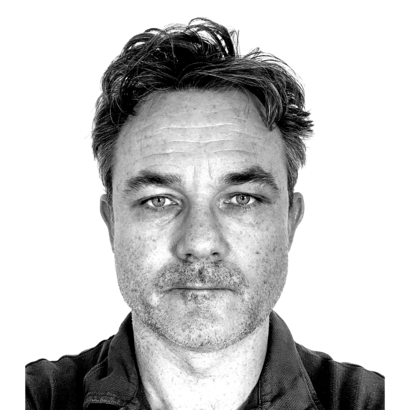Sazan Island, which lies off the coast of Albania, at the mouth of the Bay of Vlorë, between the Adriatic and Ionian Seas, has been a site of strategic importance from antiquity through the fall of the Soviet Union. During the Communist dictatorship of Enver Hoxha, which lasted from 1941 to 1985, it housed a military base and, it is rumored, a chemical-weapons plant, and access to the island was strictly forbidden. For children growing up in Vlorë, the mysteries of Sazan loomed large in the imagination.

It was only in 2015, following the gradual demilitarization of Sazan, that it became possible to visit the island for the first time in decades. For a group of local artists, it has since become a place of fascination and pilgrimage. “Sazan somehow has an apocalyptic touch,” says the artist and filmmaker Anna Baranowski, who directed the short film “Legacy,” about “bunkerization.” “You need a little courage to enter this wild island of thorns.”
Elian Stefa is the driving force behind ARTiLERIA Sazan, a grassroots arts collective that has done much to drive the resurgence of interest in the island. “The sun setting on Sazan, as seen from my hometown of Vlorë, is one of my earliest memories,” Stefa says. “Once I visited the island, I felt engulfed in a dream state. The island is a time capsule, but not of any times we know.”

Over the past seven years, initially working out of the Galeria e Bregdetit (the Gallery of the Coast), in Vlorë, artists such as Stefa have been photographing the thousands of bunkers and tunnels built underneath the island by the military, cataloguing the island’s birds and reptiles, and recording the remnants of the cinema, hospital, and schools built for garrisoned troops and their families. A summer house that appears to have been owned by Mussolini is among their discoveries.
The fortifications and concrete bunkers left over from Hoxha’s dictatorship have become one of the dominant cultural images of Albania. Built to survive a nuclear war, they are near-indestructible monuments to the country’s past. A deep ambivalence remains around what they symbolize, yet they retain a romantic appeal. These ruins of the 20th century sit alongside Albania’s relics from the Hellenistic, Byzantine, and Ottoman eras. “Thousands of bunkers are still waiting for the imaginary enemy to come,” reflects Baranowski.

Now some of the bunkers have become bars and hotels. “Visitors tend to love the fact that it has all this troubled history,” Elton Caushi, who runs the tour agency Albanian Trip, says of Sazan. Indeed, the island currently attracts many visitors from North America and Western Europe interested in discovering something not touristy. There is a compellingly perverse appeal to visiting a place that was designed to repel you.
A Paradise That Isn’t
In 1961, the Bay of Vlorë became the site of perhaps Hoxha’s greatest political victory when, in something like an Eastern Bloc analogue of the Cuban missile crisis, Albania forced the Soviet Union to abandon their shared submarine base. The episode was fictionalized by Ismail Kadare, one of Albania’s most celebrated writers, in The Great Winter (1973), which draws out the manifold ironies of a situation where these supposed Communist allies train together while plotting to deceive and entrap each other.
“Sazan was supposed to be the vanguard to protect Albania from the West,” says Stefa. “But where there used to be thousands of soldiers, there are now just a few lookouts trying to keep track of smugglers.” It has been coveted by everyone from Julius Caesar to the Venetians to Stalin, yet it also seems oddly untouched by their influence.

Parts of Sazan have a slightly sinister quality. Ammunition, gas masks, and old beds lie scattered around. It is as if you have stumbled across the aftermath of some terrible but unknown catastrophe. This unsettling strangeness is what also has made Sazan so attractive to the artists who have photographed the island as if it were some newly discovered planet. Described by one historian as less like an island than an aircraft carrier, Sazan is a paradise that isn’t.
While some older visitors are drawn by a longing for aspects of life behind the Iron Curtain—a phenomenon known as Ostalgie in Germany—Stefa and his collaborators are focused on the future, working to create a network of site-specific contemporary artworks on the island, as well as a summer school focused on experimental architecture and design. Sazan has already hosted a successful arts festival called South by the Sea.

Yet the work of these artists has inevitably sped up the process by which the unspoiled island will be developed, and there are many competing visions for what Sazan should become. In Albania, cultural trends are often imported from Greece and Italy, while popular tastes and fashions are solidly Balkan. Technological and financial investments, meanwhile, are now coming from China, Turkey, and the Gulf states, and there has been talk of building a casino. “I do hope it develops as not just another one-millionth island on the Mediterranean but as a gem of conservation of nature and history,” Caushi says.
While the Cold War invasion never came, the popularity of the artists’ work has increased the threat of Sazan being conquered by developers. For a brief moment, in the post-Communist hiatus, Sazan became a no-man’s-land where it was possible to imagine the creation of any sort of future. But the future has now begun to arrive.
Scott Anthony is a writer and a visiting fellow at the Indonesian Visual Art Archive. His novel, Changi, will be published by Penguin Random House SEA later this year


